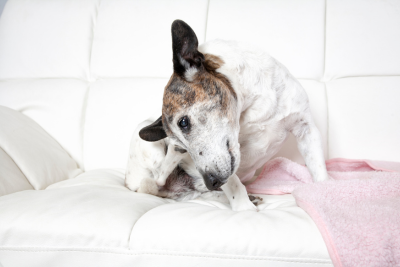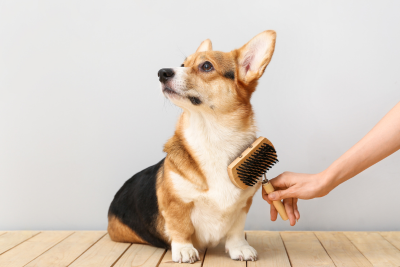Disclosure: Some articles on this site may contain affiliate links, meaning, at non additional cost to you, Chicago Urban Pets may earn a commission if you click through and make a purchase. As an Amazon Associate we earn from qualifying purchases.
You’re winding down when you hear it again—scratch scratch scratch. Your dog is at it like they’re trying to dig their way to freedom through their fur. And you wonder: Does shedding make my dog itchy? The short answer? Yes, it can! especially during periods of excessive shedding when loose fur builds up faster than usual.
A little itch during shedding season is totally normal—but too much can leave many pet parents wondering if something more serious is going on.. In this post, we’ll look at what’s normal, what’s not, and how to keep your pup comfy and your furniture a little less furry.
Is It Normal for a Shedding Dog to Be Itchy?

Itching during shedding season is often normal, but it can sometimes signal an underlying issue. The key is to observe the frequency and intensity of the scratching. Occasional itches? Totally fine. Constant scratching, red skin, or hair loss? Not so much.
Understanding the Shedding Process
Each hair on your dog’s body grows from a hair follicle, which goes through cycles of growth, rest, and shedding. This cycle is completely natural and helps your dog regulate their body temperature and maintain a healthy coat.
Shedding is a natural part of a dog’s hair growth cycle. Old hair falls out so new hair can grow in. Some dog breeds, like Huskies and Labs, shed like it’s a competitive sport, while others like Poodles and Shih Tzus barely drop a hair.
Most dogs shed more during seasonal transitions—especially spring and fall. That’s when your dog’s coat is adjusting to warmer or cooler temperatures.
How Shedding Affects the Skin
As old fur loosens and falls out, it can get trapped against the skin. This can clog pores, create mild irritation, and lead to an itchy, uncomfortable pup.
If the hair isn’t removed through brushing, it may tangle and trap dirt or moisture—basically a spa day, but in reverse. Over time, this buildup can contribute to mild skin problems and make it harder to maintain healthy skin.
When Itching Is More Than Just Shedding
Occasional scratching is totally normal. But persistent itching might also be linked to underlying skin conditions that go beyond seasonal shedding. But if your dog is itching constantly, has red patches, sores, or is losing fur in clumps, it might be more than shedding.
That’s when it’s time to consult your vet. They can check for allergies, infections, or unwanted hitchhikers (like fleas and mites).
Common Causes of Itchiness During Shedding Season

Itchiness during shedding isn’t always straightforward. There are a handful of usual suspects that may be making your dog uncomfortable this season. Let’s take a closer look at what could be behind all that scratching.
Dry Skin and Changing Seasons
Just like humans get flaky in winter, dogs can develop dry, itchy skin when the weather shifts. Low humidity, indoor heating, and less outdoor time can throw their skin barrier out of whack.
Make sure your dog stays hydrated and consider using a humidifier if your home air is Sahara-level dry. See below an example of a good humidifier for larger spaces:
Allergies (Food & Environmental)
Shedding is not the only thing that makes our dog itchy. Seasonal changes bring pollen, mold, and other allergens that can send your dog into scratch-mode. In addition to environmental triggers, food allergies are a common but often overlooked cause of itchiness. Proteins like chicken, beef, or even certain grains in dog food can irritate your pup from the inside out.
Common culprits:
- Grass, pollen, dust mites
- Certain proteins in dog food
- Chemicals in household cleaners or grooming products
Skin allergies and other allergic reactions can also explain why symptoms flare up around the same time every year or after mealtime, especially if your dog is reacting to something in their environment or diet.
Are you suffering from pet-related allergies? Here are some tips for you!
Parasites That Thrive During Shedding Times
Fleas, ticks, and mites are like uninvited guests at your dog’s shedding party. They love warm fur and can cause intense itching.
Check for:
- Tiny black specks (aka flea dirt)
- Visible insects or bites
- Excessive tail or belly chewing
A vet can recommend safe treatment options to kick them out—for good.
Is your dog prepared for flea & tick season? If not — get your order from the preferred brand Frontline at Amazon now!
Skin Infections and Hot Spots
Over-scratching from irritation or parasites can lead to secondary skin infections. Sometimes these infections are bacterial, but they can also be fungal infections, which often thrive in warm, moist areas and can be tough to spot without a vet’s help. Hot spots are red, oozing areas that appear suddenly and spread quickly.
If you notice a nasty patch, it’s vet time. The sooner it’s treated, the sooner your dog can stop doing their breakdance of discomfort. Hot spots are red, oozing areas that appear suddenly and spread quickly.
How to Tell If the Itchy Is Normal or Not

It’s not always easy to tell whether your dog’s scratching is just a harmless reaction like shedding and dry skin or something that needs attention. Paying close attention to the frequency, timing, and physical signs of when your dog is itchy can give you valuable clues.
“Good Itchy” vs. “Bad Itchy”
Some scratching is just your dog’s way of getting rid of loose fur. But constant scratching, whining, licking, or chewing is a sign that something more serious might be going on.
Red flags:
- Hair loss in patches
- Skin that looks red, swollen, or flaky
- Scratching that interrupts sleep or eating
Things You Can Monitor at Home
Keep a log for a few days. Ask yourself:
- Are they scratching in the same spot over and over?
- Is the itch worse after going outside or after meals?
- Are they licking their paws constantly?
- Is their coat dull or thinning?
These clues can help you and your vet solve the mystery of why your dog is itchy and if shedding is the culprit.
Home Remedies and Relief for Itchy, Shedding Dogs

If your dog’s scratching has gone into overdrive, don’t panic—you’ve got options. Home remedies can work wonders when the cause is mild or seasonal. Let’s explore some ways to get your pup some relief, starting with grooming.
Brushing and Grooming Tips
Regular brushing helps remove loose fur and stimulate the skin’s natural oils. It’s also a good way to keep an eye out for early signs of skin problems, like flakiness, bumps, or scabs.
Try:
- Slicker brushes for long-haired breeds
- This Cat and Dog Brush is veterinarian and Groomer tested…
- Flexible cushion pad provides added comfort for pet during…
- HOW TO USE: Ensure coat is free of loose debris. Section…
- Rubber grooming mitts for short-haired pups.
- Undercoat rakes during heavy shedding periods
These tools are gentle and effective at keeping your pet’s skin clean and comfortable during heavy shedding seasons.
Hydration and Diet
Your dog’s skin health starts from the inside out. Make sure they’re drinking enough water and getting healthy fats, especially essential fatty acids like omega-3s and omega-6s, which help maintain a healthy coat and reduce inflammation.
If your dog is eating a balanced diet, they are most likely already getting enough omega-6s, but it’s always worth adding an omega-3 supplement. Below is a good option from Amazon:
- SKIN & COAT NOURISHMENT: Fish oil for dogs and cat like Wild…
- OMEGA 3 HEALTH SUPPORT: Our omega 3 fish oil for dogs and…
- EASY-TO-MIX FORMULA: Avoid capsules with this easy salmon…
Omega-3-rich foods or supplements can do wonders for coat shine and itchiness.
Top food tips:
- Add fish oil or flaxseed to meals
- Choose high-quality kibble with skin-supporting nutrients
- Avoid fillers or common allergens like corn and soy
Here are 3 of the highest quality dry dog kibble in 2025:
Bath Time Dos and Don’ts
A gentle bath can help, but over-bathing can dry out the skin.
Use:
- Oatmeal or hypoallergenic shampoos
- Lukewarm (not hot!) water
- Conditioner for dry skin
Avoid:
- Human shampoo (way too harsh!)
- Fragrance-heavy dog shampoos
- Bathing more than once every few weeks unless directed by your vet
When to Try Supplements
If brushing and baths aren’t cutting it, supplements might help.
Consider:
- Omega-3s (fish oil capsules or liquids)
- Probiotics for gut health (which affects skin)
- Vitamin E and biotin blends
Always check with your vet before adding supplements—especially if your dog is on medication.
ps. This option has a nice variation of the supplements mentioned in this blog post.
When to Call in the Pros
If home remedies aren’t easing your dog’s discomfort, it may be time to bring in professional support. Sometimes an outside perspective (and medical know-how) is exactly what’s needed to get your pup back to their comfy, tail-wagging self.
What a Vet Can Rule Out
A vet visit can identify underlying health issues like:
- Skin infections
- Allergies
- Autoimmune conditions
- Fleas, ticks, or mange
- A skin disease that requires targeted treatment
In some cases, hormonal disorders like Cushing’s disease can cause symptoms such as excessive shedding, thinning fur, and chronic skin irritation—so it’s worth asking your vet if your dog’s symptoms seem unusual or persistent.
What a Groomer Can Help With
Groomers are shedding-season heroes.
They can:
- Do a deep deshedding treatment
- Spot skin issues early
- Recommend coat-specific tools and shampoos
If your dog hates baths (like mine) or you need backup, a professional groomer is worth every penny.
Common Questions About Shedding and Itching in Dogs

1. Does shedding make my dog itch?
Yes, it can! Shedding can lead to loose fur getting trapped against the skin, causing irritation and mild itching. During high-shedding seasons, this can become even more noticeable. However, excessive or aggressive scratching might signal something more serious, such as allergies or dry skin.
2. How do I know if my dog’s itching is normal?
Occasional scratching is normal, especially during seasonal shedding. But if your dog is itching constantly, losing hair, or seems uncomfortable, it’s time to investigate further. Keep an eye out for red patches, scabs, or behavior changes like restlessness.
3. Can my dog be allergic to their own shedding?
Not exactly. But dogs can have allergic reactions to environmental triggers that become more noticeable during shedding seasons—like pollen, dust, or certain grooming products. These allergens can settle into the fur, causing flare-ups that might be confused with reactions to the shedding itself.
4. What dog breeds shed the most and get itchy?
Breeds like Huskies, German Shepherds, and Golden Retrievers are known for heavy shedding and can be more prone to skin irritation if not groomed regularly. Their thick double coats trap loose fur, dirt, and allergens, which can lead to discomfort if not brushed out often.
5. Can a poor diet cause my dog to shed and itch more?
Yes! Lack of nutrients like omega-3 fatty acids can impact skin health. A poor diet may lead to dry, flaky skin, dull coats, and increased shedding. A balanced, nutrient-rich diet supports both coat condition and comfort.
6. How often should I bathe my shedding, itchy dog?
Not too often—every few weeks is usually enough. Over-bathing can strip natural oils and dry out the skin, making itching worse. Stick to gentle, moisturizing shampoos and always dry thoroughly after a bath.
7. Will brushing help reduce itching?
Absolutely. Regular brushing removes loose fur and distributes natural oils, both of which help reduce itching and promote a healthy coat. It’s also a great opportunity to check for any skin issues or parasites.
8. Should I be worried if my dog licks or chews their paws?
Yes, especially if it’s constant. It could be a sign of allergies, dry skin, anxiety, or even something stuck in their paw pads. Repetitive licking can also lead to secondary infections, so don’t ignore it.
9. Can shedding be a symptom of a bigger health issue?
Sometimes. Conditions like hormonal imbalances, skin infections, or parasites can cause both shedding and itching. If you notice sudden changes in shedding patterns or other symptoms like weight loss or lethargy, it’s worth calling your vet.
10. When should I seek professional help for my dog’s itching?
If the itching is frequent, your dog seems distressed, or you see visible signs of skin damage—don’t wait. Persistent scratching that disrupts sleep or leads to wounds should be checked out. Your vet can help identify the cause and recommend safe, effective treatments.
Wrapping Up: Shedding Less, Scratching Less

Dealing with a dog who’s itchy and shedding all over the place can be frustrating—but you’re not alone. Understanding what’s normal, knowing when to step in, and using the right tools and techniques can make a huge difference. Whether it’s a change in grooming habits, a better diet, or calling in your vet for backup, every step you take helps your dog feel more comfortable in their skin (and helps your couch stay a little less furry).
So the next time your pup starts scratching up a storm, you’ll know what to look for—and how to help. Hang in there, and don’t forget to celebrate the small wins. A less itchy pup is a happier pup—and that’s always worth it.








